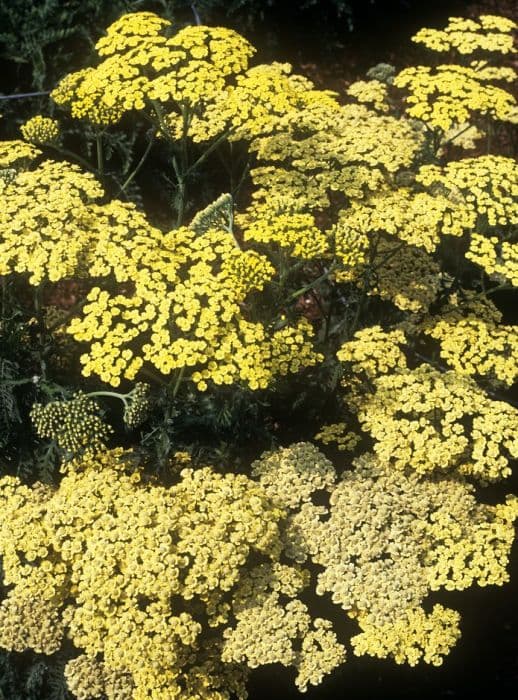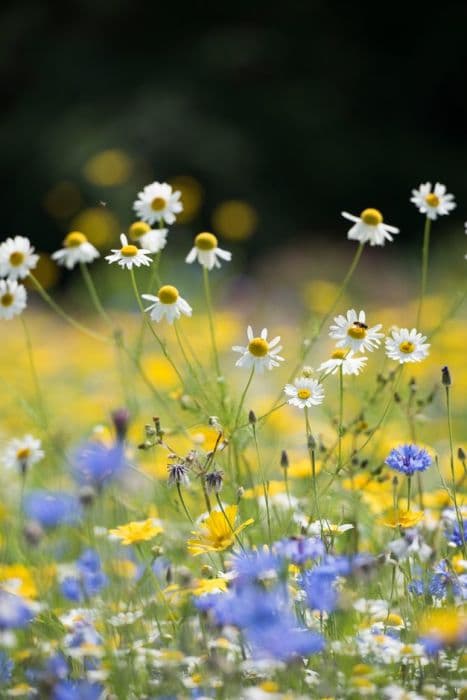Sneezeweed Helenium 'Wesergold'

ABOUT
Helenium 'Wesergold', commonly known as Sneezeweed, presents a cheerful display with its vibrant, daisy-like flowers. These blooms bear a striking golden-yellow color, which adds brightness and warmth to gardens. Each flower consists of a prominent, raised central cone that is surrounded by fringed petals that splay outwards, much like a sunburst. The central cone is typically a darker shade, often a rich brown or rusty orange, which contrasts beautifully with the golden petals. The leaves of Sneezeweed are typically lance-shaped, medium green in color, and arranged alternately on the stem. This perennial plant has an upright, clumping habit, with sturdy stems branching out and bearing numerous flower heads that blossom in the late summer to autumn period. The foliage remains attractive throughout the growing season, providing a lush backdrop for the striking flowers. Sneezeweed attracts a variety of pollinators, including butterflies and bees, which adds to the dynamic scene in any garden where it thrives.
About this plant
 Names
NamesSynonyms
Sneezeweed, Helen's Flower.
Common names
Helenium 'Wesergold'
 Toxicity
ToxicityTo humans
Helenium 'Wesergold', commonly known as sneezeweed, is considered mildly toxic to humans when ingested. Consumption of this plant can cause gastrointestinal upset, including symptoms such as nausea, vomiting, and diarrhea. In some cases, an allergic reaction may occur due to the handling of the plant or ingestion. It is advised to exercise caution and keep this plant out of reach of children who might accidentally ingest it.
To pets
Sneezeweed is also mildly toxic to pets. If ingested by dogs or cats, it can cause similar symptoms as in humans which include vomiting, diarrhea, and drooling. More severe reactions, although less common, may include lethargy, coordination problems, or an allergic reaction. If you suspect your pet has ingested sneezeweed, it is important to contact your veterinarian for proper guidance and care.
 Characteristics
CharacteristicsLife cycle
Perennials
Foliage type
Deciduous
Color of leaves
Green
Flower color
Yellow
Height
3-5 feet (0.91-1.52 meters)
Spread
2-3 feet (0.61-0.91 meters)
Plant type
Herb
Hardiness zones
3-8
Native area
North America
Benefits
 General Benefits
General Benefits- Attracts pollinators: Helenium 'Wesergold' is highly attractive to bees and butterflies, promoting pollination.
- Adds color: With its bright yellow flowers, it adds vivid color to gardens from late summer to autumn.
- Easy to grow: It is a low-maintenance plant that tolerates a range of soil types and conditions.
- Drought-resistant: Once established, it can withstand periods of dry weather, making it suitable for xeriscaping.
- Resistant to pests: It's generally resistant to common garden pests, reducing the need for chemical pesticides.
- Supports biodiversity: By providing food for pollinators, it contributes to the ecological health of the garden.
- Long blooming period: It has a long flowering season, offering visual interest for an extended period.
- Cut flowers: The blooms can be used in floral arrangements, providing an eco-friendly decor option.
- Naturalistic landscaping: Helenium 'Wesergold' fits well into wildflower gardens and naturalistic plantings.
 Medical Properties
Medical PropertiesThis plant is not used for medical purposes.
 Air-purifying Qualities
Air-purifying QualitiesThis plant is not specifically known for air purifying qualities.
 Other Uses
Other Uses- Helenium 'Wesergold', commonly known as sneezeweed, can be used in dye production; its flowers may offer a source of yellow dye for textiles.
- Insect habitat creation, as sneezeweed attracts various beneficial insects such as butterflies and bees which can enhance biodiversity in gardens.
- Erosion control in landscaping, since sneezeweed can establish quickly and help stabilize soil on slopes and banks.
- As a companion plant, sneezeweed may help deter certain pests in vegetable gardens or agricultural settings.
- Used ceremonially in some cultures to mark the changing seasons due to its late summer and fall blooming period.
- Floral arrangements, as both fresh and dried sneezeweed flowers can make for striking additions to bouquets or indoor displays.
- Photography subject for nature enthusiasts given its vibrant, photogenic blooms.
- Educational tool in botany and horticulture programs, as sneezeweed's growth patterns and pollinator-attracting characteristics provide learning opportunities.
- Part of a rain garden plant ensemble designed to manage stormwater runoff naturally.
- Backyard wildlife support, since sneezeweed can offer food and shelter for birds and small mammals.
Interesting Facts
 Feng Shui
Feng ShuiThe Sneezeweed is not used in Feng Shui practice.
 Zodiac Sign Compitability
Zodiac Sign CompitabilityThe Sneezeweed is not used in astrology practice.
 Plant Symbolism
Plant Symbolism- Grief Recovery: Helenium 'Wesergold', commonly known as Sneezeweed, has ties to Greek mythology where it is said to have sprung from the tears of Helen of Troy. This connects the plant to themes of overcoming sorrow and recovering from grief.
- Protection: Folklore suggests that Helenium was used to ward off evil spirits and bad luck, which is why it sometimes symbolizes protection.
- Good Fortune: Despite its association with sneezing, which is thought to ward off ill health and misfortune, Sneezeweed also symbolizes good luck in certain cultures.
- Persistence: With its ability to thrive in difficult conditions, the Sneezeweed represents persistence and the ability to endure challenging situations.
 Water
WaterSneezeweed should be watered deeply and regularly, especially during dry spells, to keep the soil consistently moist but not waterlogged. Aim for about 1 inch of water per week, either from rainfall or manual watering, which is roughly equivalent to 0.6 gallons per square foot every seven days. Gradually pour water at the base of the plant rather than overhead to avoid soaking the foliage, which can lead to disease. During the peak of summer, you may need to water sneezeweed every few days to maintain moisture levels, while reducing frequency in cooler weather.
 Light
LightSneezeweed thrives in full sun, meaning at least 6 to 8 hours of direct sunlight each day. The best spot for planting sneezeweed is an area that receives unobstructed sunlight throughout the day. If grown in too much shade, the stems may become weak and the plant might not flower as profusely.
 Temperature
TemperatureSneezeweed is hardy and can tolerate a wide range of temperatures, but it grows best in conditions that mirror its native environment. It can survive minimum temperatures down to about -30 degrees Fahrenheit and is comfortable in the heat up to about 90 degrees Fahrenheit. Ideally, sneezeweed prefers temperatures between 50 and 75 degrees Fahrenheit, which promote healthy growth and flowering.
 Pruning
PruningPruning sneezeweed encourages bushiness and can increase the number of blooms. In late winter or early spring, cut back the previous year’s growth to about 4 to 6 inches above the ground. Additionally, deadheading, or removing spent flowers during the growing season, will promote continuous blooming. Pruning is not strictly necessary every year, but it can help maintain a tidy appearance and stimulate healthy growth.
 Cleaning
CleaningAs needed
 Soil
SoilSneezeweed 'Wesergold' thrives in well-draining soil rich in organic matter, with a pH range between 5.5 and 7.0. A mix containing garden soil, peat, compost, and a small amount of sand or perlite is ideal to facilitate proper drainage and provide the necessary nutrients.
 Repotting
RepottingSneezeweed 'Wesergold' does not typically require frequent repotting. It is a perennial that is often left undisturbed in the garden but may be divided every 3 to 4 years to maintain vigor and prevent overcrowding.
 Humidity & Misting
Humidity & MistingSneezeweed 'Wesergold' is adaptable to a wide range of humidity conditions and does not require any special humidity considerations. It thrives in the ambient outdoor humidity levels found in its growing zones.
 Suitable locations
Suitable locationsIndoor
Ensure bright light, moderate water, and good air flow.
Outdoor
Full sun, rich soil, moderate watering, divide when crowded.
Hardiness zone
3-8 USDA
 Life cycle
Life cycleHelenium 'Wesergold', also known as Sneezeweed 'Wesergold', starts its life cycle from seed, which, when sown, germinates in warm, moist soil conditions typically within 1-2 weeks. The seedlings develop true leaves and establish a strong root system during their first growing season. As a perennial, it enters a stage of vegetative growth each spring, producing a clump of foliage and stems that increase in size and number annually. During late summer to fall, the plant blossoms, producing distinctive yellow flowers attractive to pollinators such as bees and butterflies. After flowering, the plant sets seed, which can be dispersed by wind or wildlife, perpetuating the life cycle. Finally, Helenium 'Wesergold' enters dormancy in winter, dying back to the ground before resuming growth in the next season.
 Propogation
PropogationPropogation time
Spring-early summer
The most popular method of propagation for Helenium 'Wesergold', commonly known as Sneezeweed, is by division. This is typically done in early spring or autumn. To propagate by division, carefully lift the entire clump of the plant from the ground using a garden fork. Once lifted, use a sharp, clean knife or spade to gently divide the clump into smaller sections, making sure each section has a good amount of roots attached. Replant these divisions at the same depth they were originally growing, and water them well. This method not only helps to propagate new plants but can also rejuvenate older clumps that have become woody or less vigorous. Dividing every few years keeps the plant healthy and prevents overcrowding.









